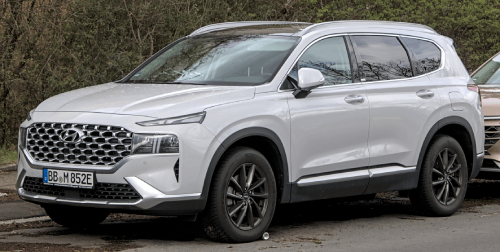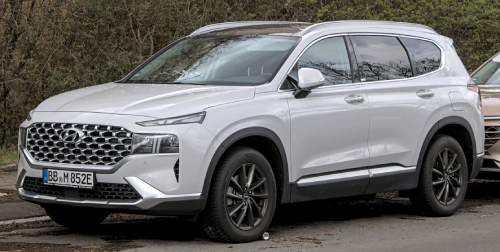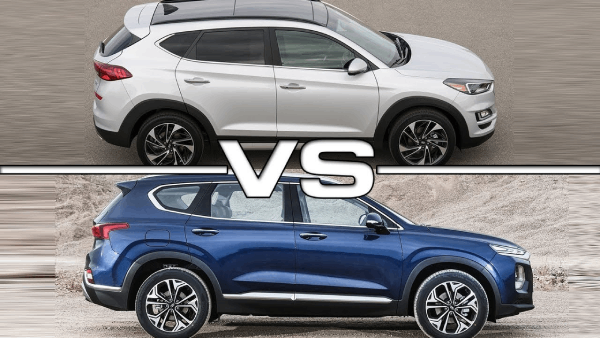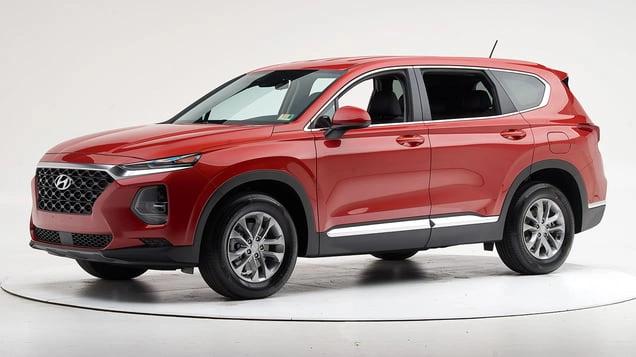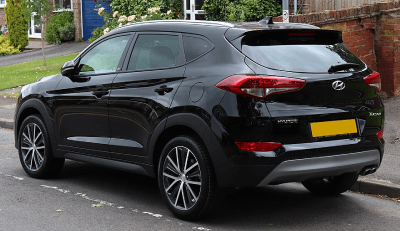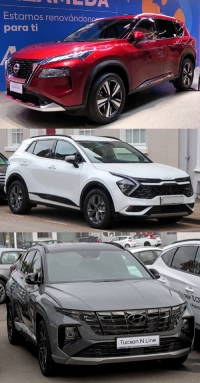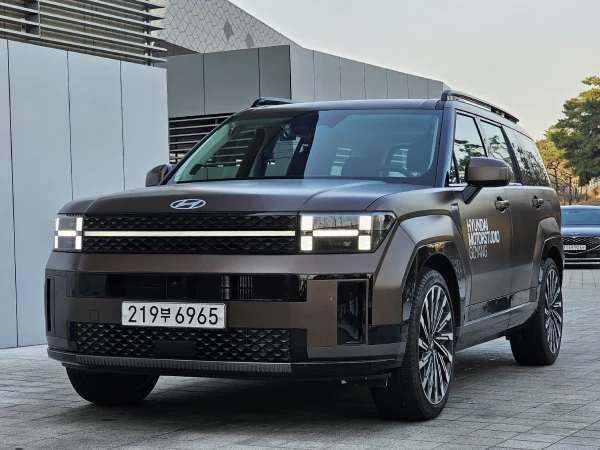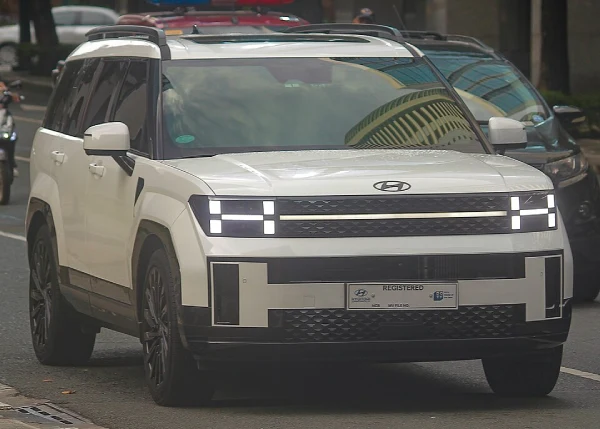Even though the Hyundai Santa Fe has been getting better over time, not every model year offers the same amenities. Some have had serious problems that have affected your experience as an owner. To assist you in deciding whether the Hyundai Santa Fe is a dependable vehicle, we’ll look at common issues, recalls, and owner reviews.
The Five Worst Years for the Hyundai Santa Fe
The Hyundai Santa Fe has a lot to offer, but because of a number of issues, the models from 2007, 2009, 2013, 2014, and 2017 don’t get the best reviews. Even with numerous recalls to fix the problems, these are still the worst model years to avoid.
Santa Fe, 2007
Despite being a popular and reasonably priced option, the 2007 Hyundai Santa Fe is frequently regarded as one of the least dependable vehicles. Almost 700 complaints have been filed, including gearbox faults, airbag malfunctions, and electrical concerns.
Due to documented airbag incidents and malfunctioning brake light switches, safety concerns are especially prevalent. The vehicle’s long-term dependability has been called into question by these problems as well as a troublesome gasoline sender.
Defective interior accessories, problems with the fuel distribution system, and engine breakdowns often irritate drivers. For example, a broken brake light switch can obscure vision, and a damaged clock spring can stop the driver’s side airbag from deploying in an accident.
These shortcomings are too serious to ignore in spite of its brand-new unibody base and features.
Santa Fe, 2009
The displeasure was exacerbated in 2009 by the persistence of fuel-related issues from previous models, particularly with malfunctioning fuel sensors.
Although the larger V6 is only slightly better, the standard V6 engine performs poorly and provides little power. Although the SUV’s fuel efficiency—roughly 20 mpg—is mediocre for its class, owners have also been disappointed by the vehicle’s deteriorating gas mileage over time.
The engine has many problems, ranging from catastrophic breakdowns to high consumption and oil leakage. Owners often report that the engine stalls or dies during driving, typically after 93,000 miles. Its reputation as being unreliable is mostly due to these ongoing engine issues, which can include total engine replacement or failure.
The 2009 Santa Fe may not be the long-lasting car some people might anticipate from the Hyundai name, as seen by the frequent need for expensive repairs and the aggravation of handling problems like difficult shifting and engine stalls.
Santa Fe, 2013
Although not a total failure, the 2013 Hyundai Santa Fe has a number of serious problems that make it a less-than-ideal option for many consumers.
Engine issues are very prevalent; drivers describe jerks, odd noises, oil leaks, and sometimes total engine failure. Hyundai recalled certain 2013 models due to premature bearing wear and a fuel level sensor, but there were no specific recalls for these problems.
The 2013 Santa Fe’s engine repairs are probably going to be costly and time-consuming. Engine issues account for 176 of the 431 complaints, with the fuel/propulsion system, powertrain, and vehicle speed control accounting for the remaining complaints.
Although a 10-year-old car’s engine is likely to fail, some drivers have reported engine problems at very low mileage—as low as 120,000 miles.
A malfunctioning anti-lock brake system (ABS) module is another significant problem with the 2013 Santa Fe. To stop wheel lockup and skidding, this module analyzes data from the wheel-speed sensor and hydraulic brake system.
Even under typical braking circumstances, a broken ABS module might cause the brakes to lock up and behave strangely. The ABS warning light coming on is a sign of this problem. To fix this issue, Hyundai recalled more than 150,000 2013 Santa Fe models.
Santa Fe, 2014
Many owners have complained about the 2014 Hyundai Santa Fe’s engine issues, which are identical to those of its previous versions. Online forums are overflowing with reports of engine problems that necessitate expensive repairs or even total engine replacements.
We own a used 2014 Hyundai Santa Fe, and we’ve only experienced problems with it. Our team once experienced an unexpected engine failure while traveling on a highway. To get it hauled to a mechanic, we had to call a tow truck.
We were informed by the mechanic that the power plant needed to be replaced because it was broken. While others did not have the same luck, we were fortunate that the engine was still under warranty. We’ve heard that the engine issue required thousands of dollars to rectify.
The 2014 Santa Fe has experienced steering system problems in addition to engine problems. The steering feels unresponsive, according to several owners, which makes it challenging to keep the vehicle in its lane, particularly when traveling at high speeds on the highway. Despite numerous trips to repair shops, many owners have been unable to find a long-term solution to this problem.
The overall ranking of the 2014 Santa Fe has been affected by its problems. It’s hardly surprising that many buyers are reluctant to buy a secondhand 2014 model given the NHTSA’s five recalls and four investigations.
Santa Fe, 2017
The automatic transmission is one of the main grievances of 2017 Santa Fe owners. Numerous people have complained of slippery gears, abrupt shifting, and even a discernible lag when accelerating. We witnessed this ourselves when my Santa Fe almost collided with a post because the transmission took two to three seconds to engage.
Another source of annoyance has been steering problems. Particularly when traveling on highways, several drivers have observed their car tugging to one side, which makes for a less comforting ride. Many have turned to replacing or recalibrating the steering motor in order to address this.
Engine stalling has also been reported, especially when traveling uphill or with heavy loads. Such behavior poses a major risk to safety and may require expensive repairs. In order to remedy engine bearing wear, which was found to be the primary cause of the stalling issues, Hyundai issued a recall.
Regrettably, the 2017 Santa Fe has become less reliable; the NHTSA website currently has over 700 complaints.
What Are The Opinions Of The Former Owner Regarding Their Santa Fe?
The Hyundai Santa Fe is still a dependable SUV for the majority of model years; however, a few particular years have serious and expensive problems. The following list of typical problems that Santa Fe owners face highlights which model years receive the most complaints.
Transmission Hesitancy: Many owners have reported experiencing transmission hesitation problems with the 2017 Hyundai Santa Fe after just 1,000 miles. The issue gets worse when you accelerate or turn. Particularly when merging into traffic, this hesitancy can present significant risks.
Speaker Issue: Speaker problems have been reported by owners of Santa Fe vehicles from 2008–2009 and 2011–2017, typically occurring after 50,000 km. This problem usually requires a hard reset that involves the battery.
Engine Stalling: A malfunctioning crankshaft position sensor is frequently the cause of the 2014 Hyundai Santa Fe’s engine stalling issues. Numerous owners complained that their cars would shut down when traveling at high speeds, posing a risk.
Transmission Stuttering: The 2014 Santa Fe also has transmission stuttering, which is particularly apparent while putting the car in second or third gear. This problem affects both front-wheel-drive and all-wheel-drive versions. The issue usually manifests as a jarring shift from park to drive when the car is first driven.
Engine Failure: Engine issues have resulted in expensive repairs, frequently necessitating engine replacements at just 80,000 miles, particularly in the 2012 and 2013 model years.
Airbag Malfunction: Airbag problems are another issue, especially with the 2010 and 2003–2006 vehicles, where the airbag lights show erratic illumination. In order to address unintentional airbag activation, particularly while a kid car seat is in the front passenger seat, a recall was issued for models manufactured between 2007 and 2009.
Paint Problems: Owners of the 2009 and 2004 Santa Fe models have noticed paint peeling and chipping between 70,000 and 90,000 kilometers. The expense of repainting can exceed $2,800.
Fuel Level Sensor Failure: Inaccurate fuel readings and unplanned engine shutdowns while driving are caused by defective fuel level sensors, which are a problem with both the 2007 and 2008 Santa Fe models.
Which Years Are Best for Investing in a Hyundai Santa Fe?
Certain Hyundai Santa Fe model years are particularly noteworthy for their consistent performance and lower number of owner-reported problems when selecting a dependable vehicle. Investing during these years guarantees that you will receive the best return on your investment with the fewest worries.
With fewer complaints and a respectable range of engines, the 2006 Santa Fe is a dependable option for those on a tight budget. It might not have all the features of more recent versions, but it consistently provides the necessities.
With a reliability rating of four out of five from Consumer Reports, the 2015 Hyundai Santa Fe year model combines cutting-edge technology with potent performance. It is a car that offers long-term owners peace of mind and a nice ride.
The 2018 Hyundai Santa Fe merits notice for its exceptional features and driving pleasure. With special standard safety features including Hyundai’s Blue Link system and a rearview camera, this model delivers enhanced engine performance.
For those looking for the newest technologies, the Hyundai Santa Fe models from 2019 and 2020 are great options. They have cutting-edge safety technologies, including adaptive cruise control and forward-collision warning.
What is the average mileage of a Hyundai Santa Fe?
With a reliability rating of second out of 26 midsize SUVs, many Hyundai Santa Fe models have continuously demonstrated their dependability. Compared to its competitors, which usually need 0.4 trips to the repair shop annually, it stands out with only 0.2 unscheduled repairs.
The Hyundai Santa Fe can easily achieve 200,000 to 250,000 miles with proper maintenance. Numerous owners have stated that they have driven their Santa Fes well past this point without experiencing any significant problems.
Make routine maintenance a top priority to guarantee your Santa Fe performs at its best. Below is a summary of crucial checks:
Frequent Upkeep: To prolong the life of your Santa Fe, you must follow a rigorous maintenance regimen.
Changes for Engine Oil: For best lubrication and performance, change your engine oil every 3,000 to 5,000 miles.
Air Filter Replacement: To ensure that the engine is receiving enough air, change your air filter every 12,000 miles.
Tire Care: To extend the life of your tires, rotate them every 5,000 to 8,000 miles and maintain the recommended PSI.
Fluid Checks: Check the levels of your power steering fluid, brake fluid, transmission fluid, and antifreeze on a regular basis.
Upkeep of Batteries: Examine your battery for indications of corrosion, damage, or low charge.
Are Hyundai Santa Fe Vehicles Reputable and Valuable?
Yes, the majority of Hyundai Santa Fe models—aside from the ones already mentioned—are dependable vehicles that are therefore a good investment. Its dependability and durability have continuously earned it high evaluations. With a 94.3% score, Hyundai actually outperformed Ford, Skoda, and VW in terms of overall dependability.
Compared to other midsize SUVs, the Santa Fe has substantially lower maintenance and repair costs, which makes it more cost-effective over time. Additionally, compared to its rivals, it needs less unplanned maintenance, guaranteeing a more dependable and hassle-free ownership experience.
